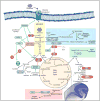Beyond Alkylating Agents for Gliomas: Quo Vadimus?
- PMID: 28561663
- PMCID: PMC5803081
- DOI: 10.1200/EDBK_175003
Beyond Alkylating Agents for Gliomas: Quo Vadimus?
Abstract
Recent advances in therapies have yielded notable success in terms of improved survival in several cancers. However, such treatments have failed to improve outcome in patients with gliomas for whom surgery followed by radiation therapy and chemotherapy with alkylating agents remain the standard of care. Genetic and epigenetic studies have helped identify several alterations specific to gliomas. Attempts to target these altered pathways have been unsuccessful due to various factors, including tumor heterogeneity, adaptive resistance of tumor cells, and limitations of access across the blood-brain barrier. Novel therapies that circumvent such limitations have been the focus of intense study and include approaches such as immunotherapy, targeting of signaling hubs and metabolic pathways, and use of biologic agents. Immunotherapeutic approaches including tumor-targeted vaccines, immune checkpoint blockade, antibody-drug conjugates, and chimeric antigen receptor-expressing cell therapies are in various stages of clinical trials. Similarly, identification of key metabolic pathways or converging hubs of signaling pathways that are tumor specific have yielded novel targets for therapy of gliomas. In addition, the failure of conventional therapies against gliomas has led to a growing interest among patients in the use of alternative therapies, which in turn has necessitated developing evidence-based approaches to the application of such therapies in clinical studies. The development of these novel approaches bears potential for providing breakthroughs in treatment of more meaningful and improved outcomes for patients with gliomas.
Conflict of interest statement
Disclosures of potential conflicts of interest provided by the authors are available with the online article at
Figures

References
-
- Horneber M, Bueschel G, Dennert G, et al. How many cancer patients use complementary and alternative medicine: a systematic review and metaanalysis. Integr Cancer Ther. 2012;11:187–203. - PubMed
Publication types
MeSH terms
Substances
Grants and funding
LinkOut - more resources
Full Text Sources
Other Literature Sources

